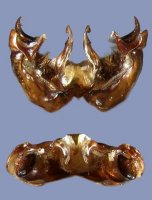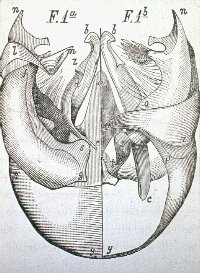|
Find
world species by species group*
click
on a subgeneric name:
Simplified
subgeneric classification of the bumblebees reducing
the number of subgenera from 38 to 15 (Williams et
al., 2008
[pdf]), which are placed in a single genus Bombus.
The phylogenetic tree for the subgenera is based on
an analysis of DNA sequence data for five genes (Cameron
et al., 2007
[pdf]).
Only clades with strong support (Bayesian posterior
probability >0.95) are shown.
*
Click
here to see the recent changes to the subgeneric arrangement
of species.
Keys
to subgenera
Estimate
of phylogenetic relationships
Subgenera
Keys to subgenera
Species
groups
.
Estimate
of phylogenetic relationships
The
phylogenetic tree adopted here is based on an analysis
of DNA sequence data from five genes (Cameron
et al., 2007
[pdf]).
It is strongly supported, and includes almost all known
bumblebee species.
Species are listed here in an order that represents
their phylogenetic relationships (after the sequencing
convention of Nelson, 1972)
as these are understood from this phylogenetic study.
This
estimate of bumblebee phylogeny provides further evidence
that the use of Psithyrus as a genus for the
principal group of socially parasitic species separate
from the remainder of the social bumblebees in Bombus
is unjustified. Therefore a single genus Bombus
is used for all of the species of bumblebees (see the
comments on the subgenus Psithyrus).
An
alphabetic index to all
names in the checklist (but not all known bumblebee
names) and a summary list
is provided.
.
Subgenera
Since
1880, a system of subgenera has come to be widely used
by specialists who wish to label groups of species that
are thought to be more similar by various criteria (e.g.
Dalla Torre, 1880; Radoszkowski,
1884; Robertson, 1903;
Vogt, 1911; Skorikov,
1914; Krüger, 1920;
Skorikov, 1923; Richards,
1929, 1968). Subgenera
are in common use in the bumblebee literature. A historical
review of the development of generic and subgeneric
classifications of bumblebees is given by Ito (1985).
However, the subgeneric system had become unweildy with
38 subgenera, many of them with only one or two species
and some of them undiagnosable or polyphyletic. Consequently
the subgeneric system had come to be seen widely as
unnecessarily complicated. Williams et al. (2008
[pdf]) suggest criteria for simplifying the subgeneric
system, and using the most
reliable and nearly complete estimate
of phylogeny from
Cameron et al. (2007
[pdf]),
they reduced the system from 38 to a more manageable
15 subgenera (see the tree above),
![Skorikov ([1923]) [Palaearctic bumblebees]](skorikov23_classification.gif)
Skorikov's
1923 generic and subgeneric classification of bumblebees,
which provided many of the names for the more recent
subgeneric classifications of bumblebees.
For most of its history, the bumblebee subgeneric system
was developed using characters of the male
genitalia. This was because morphological characters,
those of the male genitalia show particularly high levels
of congruence. For a brief account of adult morphology
in general, and of the male genitalia in particular,
see Williams (1991
[pdf] ). Images of male genitalia are provided here
for most species (others are available but unphotographed)
by subgenus. Note that the
use of the terms
describing their parts has differed among authors.
|
Male
genitalia of B. ruderarius
from the dorsal (above) and
posterior (below) aspects.

|
|
Male
genitalia of B. ruderarius
from the dorsal (left) and
ventral (right) aspects.

|
Several
authors have commented that the recent
system of 38 subgenera (the system summarised in
Williams, 1998; Michener,
2000, 2007) was too
complicated. In the New World, for example, both the
monophyletic fraternus-group of subgenera and
the subgenus Fervidobombus are endemic, and these
are the only two groups represented south of the Panama
isthmus. But whereas Fervidobombus has been treated
nearly consistently as a single, relatively large subgenus
(20 species in this list), the fraternus-group
in a broad sense (also 20 species in this list) had
been split into 10 subgenera.
Now
that a well supported estimate of phylogeny is available,
Williams et al. (2008
[pdf]) suggested that the subgeneric system could
be simplified reliably. This has reduced the number
of subgenera from 38 to 15 and has reduced the number
of subgenera with only a single species from 11 to 1
(see the summary table below, or click
here for the full list):
|
Subgenus
|
Subgeneric
abbreviation |
Number
of species
|
|
|
1
2
3
4
5
6
7
8
9
10
11
12
13
14
15
|
Mendacibombus
Bombias
Kallobombus
Orientalibombus
Subterraneobombus
Megabombus
Thoracobombus
Psithyrus
Pyrobombus
Alpinobombus
Bombus s. str.
Alpigenobombus
Melanobombus
Sibiricobombus
Cullumanobombus
|
Md
Bi
Kl
Or
St
Mg
Th
Ps
Pr
Al
Bo
Ag
Ml
Sb
Cu |
12
3
1
3
11
23
51
26
50
8
17
8
18
8
23
|
|
Full
synonymy of subgeneric names for the new simplified
subgeneric system is included in this checklist. Also
included are details of subgeneric type species, because
these have been revised since Richards (1968).
The given generic combination for subgeneric names is
shown. Where a genus-group name was published at the
rank of genus and subsequently treated at subgeneric
rank, the first such action is listed separately. The
two-letter abbreviations for subgeneric names (see the
table above) are based on those used by Ito (1985).
.
Keys
to subgenera
Illustrated
keys are available here to help in identifying all of
the world's bumblebees to subgenus from their morphology.
There are keys in the traditional dichotomous format:
Click
here for a pdf key to subgenera (females)
Click
here for a pdf key to subgenera (males)
A
Lucid matrix
key is also available, which allows the user to choose
characters in any order. This is a test version. At
present the illustrations are far from complete, but
as a work in progress it may still be useful. Comments
and suggestions are welcomed.
Click
here for a Lucid key to subgenera (females and
males)
.
Species
groups
The
more distinctive groups of species within subgenera
can be referred to using interpolated species-group
names when this is useful. Like subgeneric names, the
use of these names is not obligatory. A selection of
potentially useful names is provided in grey within
the pages on subgenera. These names are derived from
the oldest valid name among the species included within
the group.
.
research publications
| books on British bumblebees
| links and credits
 top of page
top of page
|